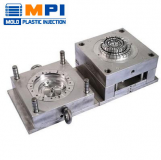Are you looking for ways to improve your mold making process? Hot runner systems might just be the solution you’re looking for. These systems are designed to optimize the injection molding process by eliminating the need for runners, making it more efficient and cost-effective. In this blog, we will discuss what hot runner systems are, their purpose in a mold, and the key advantages they offer.
From reduced cycle time to improved part quality, and minimal material wastage to versatile applications in various industries, hot runner systems can help take your production process to the next level. We will also cover some of the disadvantages of hot runner systems so that you can make an informed decision on whether or not they are right for your business. Read on to find out more about how hot runner systems can benefit your mold making technology.
What are hot runner systems?
Hot runner systems are a type of injection molding technology that is widely used in the manufacturing industry. These systems use heated components to keep the plastic in a molten state, resulting in faster cycle times and reduced material waste compared to traditional cold runner systems. They also offer improved part quality and consistency by reducing issues like weld lines or sink marks. Ideal for producing complex parts with tight tolerances and multiple gates, hot runner systems can be customized for specific molding applications, offering flexibility and versatility.
While maintenance and repair of hot runner systems can be more complex than traditional molding systems, proper care can extend their lifespan, making them a valuable asset in many manufacturing settings. Overall, the use of hot runner technology can lead to cost savings and improved efficiency over time, making it an essential component of modern mold making technology.
What is the purpose of a runner on a mold?
Runners play a crucial role in the injection molding process, serving as channels to deliver molten plastic from the machine into the mold cavity. Traditional cold runner systems can result in significant material wastage and longer cycle times due to their need for a separate runner system, which is discarded after each cycle.
Hot runner systems are designed to eliminate this issue, providing faster production cycles and reduced material waste. By using heated components, hot runners keep the plastic in a molten state, allowing it to flow more smoothly into the mold cavity without the need for a separate runner system. This feature not only saves time but also reduces material costs, making them an attractive option for manufacturers looking to optimize their processes.
Hot Runner System- Components Overview:
Hot runner systems are a type of injection molding technology that offers several advantages over traditional cold runner systems. These systems consist of various components such as the nozzle, manifold, heater, temperature controller, and gate which work together to distribute molten plastic to the mold cavity.
Compared to cold runner systems, hot runner systems offer faster cycle times and reduced waste, making them more cost-effective for high-volume production runs. Additionally, hot runner systems allow for greater design flexibility and precision in producing complex parts with improved quality control.
Key advantage 1: Reduced cycle time
Reducing cycle time is a crucial factor in improving the efficiency and cost-effectiveness of injection molding. Hot runner systems offer a significant advantage in this regard. By eliminating the need for a cold runner, hot runners can reduce cycle time by up to 50%. The molten plastic flows directly into the mold cavity, reducing cooling time and enabling faster production rates.
In addition to faster cycle times, hot runner systems also provide increased design flexibility and better part quality. With reduced cooling time, parts are less likely to experience warping or distortion. Overall, reduced cycle time is just one of the many advantages that hot runner systems offer in modern molding technology.
Key advantage 2: Cost-effective
Reducing costs is a top priority for businesses today, and hot runner systems offer an excellent opportunity to achieve cost savings. One of the most significant advantages of hot runner systems is the reduction in material waste.
Traditional cold runner systems can result in large amounts of wasted material, which can be costly over time. In contrast, hot runner systems eliminate the need for a cold runner, reducing waste and saving money. By reducing scrap rates and optimizing production processes, hot runner systems help businesses operate more efficiently and cost-effectively.
Key advantage 3: Improved part quality
Improved part quality is one of the most significant advantages of using hot runner systems. By reducing or eliminating gate marks and weld lines, hot runner systems can help improve the final product’s appearance and strength. Additionally, they allow for greater design flexibility, enabling the creation of complex geometries that would be impossible with traditional molding methods.
The consistency in part dimensions and weight also contributes to improved quality, making hot runner systems a popular choice among manufacturers seeking to produce high-quality parts efficiently. With hot runner systems, it’s possible to produce larger parts with better surface finishes, further enhancing the overall quality of the final product.
 The three key factors affecting mold cost have nothing to do with materials!
The three key factors affecting mold cost have nothing to do with materials!  10 Plastic Injection Processes – Advantages, Disadvantages, And Applications Of Plastic Injection
10 Plastic Injection Processes – Advantages, Disadvantages, And Applications Of Plastic Injection  Plastic Injection Mold Material Guide – Advantages & Applications Of 20 Common Injection Molding Materials
Plastic Injection Mold Material Guide – Advantages & Applications Of 20 Common Injection Molding Materials  Custom Plastic Mold Injection Molds: Revolutionizing Manufacturing Processes
Custom Plastic Mold Injection Molds: Revolutionizing Manufacturing Processes